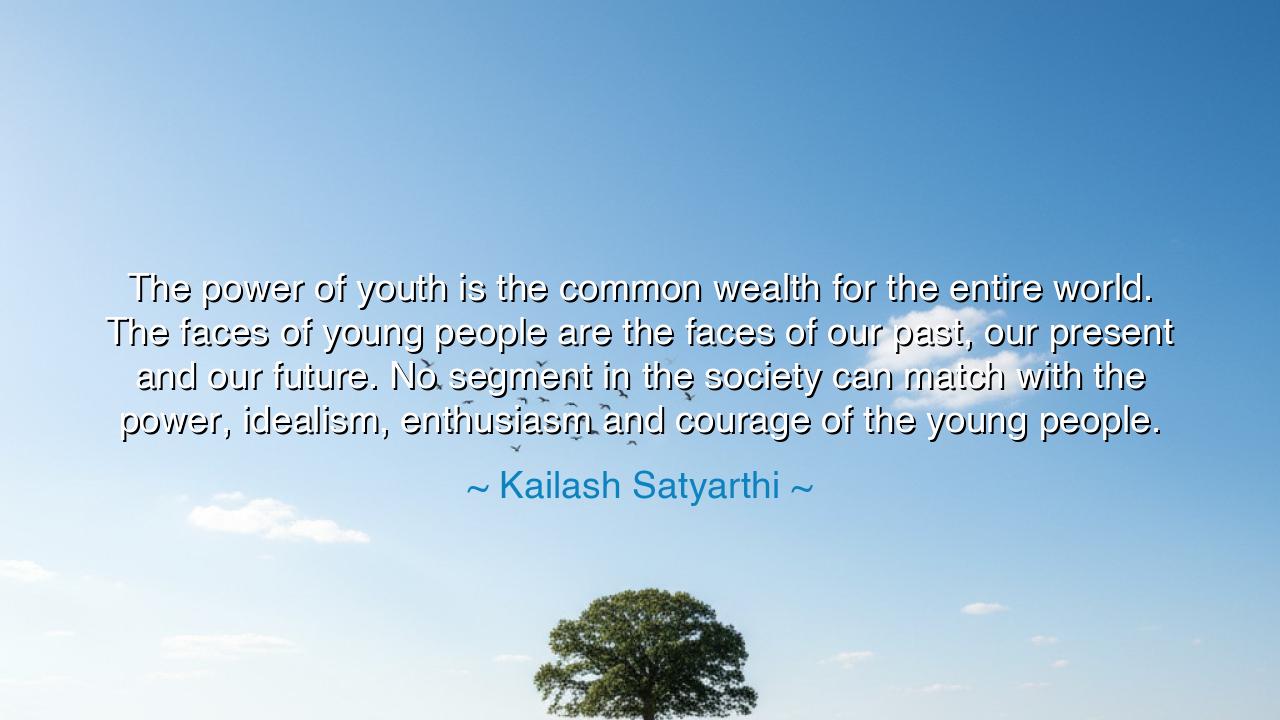
The power of youth is the common wealth for the entire world. The
The power of youth is the common wealth for the entire world. The faces of young people are the faces of our past, our present and our future. No segment in the society can match with the power, idealism, enthusiasm and courage of the young people.






In the stirring words of Kailash Satyarthi, “The power of youth is the common wealth for the entire world. The faces of young people are the faces of our past, our present and our future. No segment in society can match with the power, idealism, enthusiasm, and courage of the young people,” we are reminded of the profound potential and vitality that young people hold. Satyarthi emphasizes the unique position that youth occupies in shaping the course of humanity, serving as both the reflection of history and the harbingers of the future. In this recognition, there is a call to celebrate, invest in, and honor the energy and vision of the younger generations, for they carry the seeds of change that will flourish in the years to come.
This idea of youth being a central force in the continuum of human progress has deep roots in the teachings of the ancients. The Greek philosophers, particularly Plato, believed that the youth were the lifeblood of society, for they represented the future of reason, virtue, and justice. Plato envisioned an ideal state in which the wisdom of the elders would guide the passion of the young, directing their energy toward the common good. The young were seen as both the foundation for the future and the bearers of the ideals that would transform the world. Satyarthi’s words mirror this ancient vision, recognizing that the power of the youth lies not only in their enthusiasm but also in their capacity to change the course of history.
Aristotle, the great student of Plato, also saw the youth as central to the development of society, though he cautioned that this energy must be guided by wisdom and tempered with moral education. Aristotle argued that while the idealism of youth is a powerful force, it must be cultivated and directed toward the pursuit of virtue. He believed that the strength of youth is a great asset, but only when it is informed by the knowledge of the past and guided by a sense of justice. Satyarthi echoes this sentiment, acknowledging the raw potential of the young while emphasizing the need to channel it in ways that benefit society as a whole. The idealism of youth, when nurtured, can lead to extraordinary changes in the world, just as Aristotle believed.
The story of Nelson Mandela, a man who spent 27 years in prison fighting against apartheid, offers a modern example of the power of youth in transforming society. Mandela was deeply influenced by the young activists around him, whose enthusiasm, idealism, and courage spurred him to continue his fight for justice even when the odds seemed insurmountable. His youthful spirit remained intact even in the harshest of conditions, and his resolve to change the future for his people was fueled by the energy of a younger generation demanding freedom and equality. Mandela’s eventual triumph was not solely the result of his efforts but also of the youth who stood alongside him, whose voices and actions could not be ignored. Like Satyarthi’s assertion, Mandela’s story reveals the immense power of youth to change the world and to inspire even the most seasoned leaders to act.
This dynamic between youth and change is further exemplified by the Civil Rights Movement in the United States, particularly through the leadership of young figures like Ruby Bridges, who, at just six years old, bravely desegregated a New Orleans school, and John Lewis, whose lifelong commitment to nonviolent protest was sparked in his youth. These young people, armed with the idealism and courage of their generation, became the catalysts for one of the most significant social transformations in American history. Their actions proved that, as Satyarthi suggests, no other segment of society can match the enthusiasm, vision, and unwavering commitment of the young.
The central lesson of Satyarthi's words is that the youth are not to be dismissed as inexperienced or naive but recognized as the vital force that will carry the torch of progress forward. Their idealism and passion are not merely the energy of the present; they are the future of civilization. Satyarthi calls us to invest in young people, to nurture their growth and guide their passion toward building a better world. In their hands lie the hope and potential of future generations, and it is our responsibility to ensure that this power is harnessed with wisdom and purpose.
In practical terms, we can take Satyarthi’s message to heart by supporting and empowering the youth around us. This means listening to their voices, valuing their contributions, and providing them with the tools, knowledge, and opportunities to make meaningful change. Whether through education, mentorship, or activism, we must create spaces where young people can thrive and be part of the conversations that shape our world. The power of youth is not an abstract concept—it is a tangible force that can shape the future if we choose to recognize and nurture it. Just as the ancients recognized the transformative power of the young, so too must we honor and embrace their potential, for they are the ones who will carry us forward into a brighter tomorrow.






AAdministratorAdministrator
Welcome, honored guests. Please leave a comment, we will respond soon